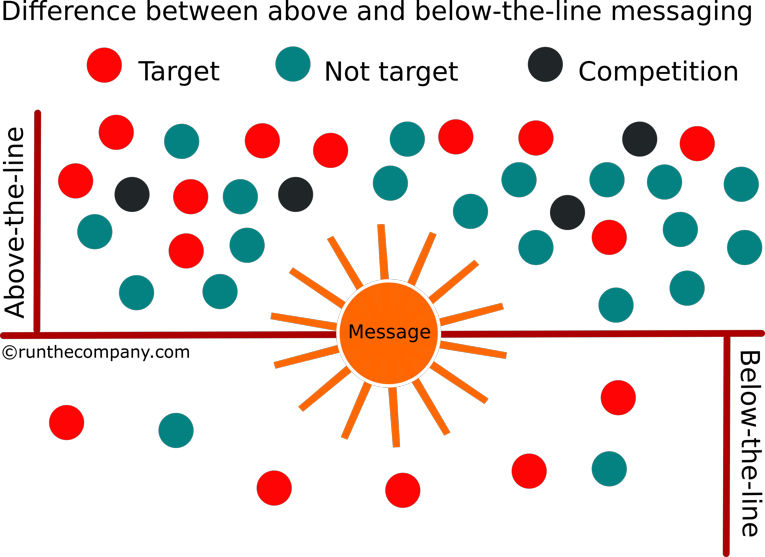Above and below-the-line messaging

Quick term to remember: marcom = marketing communications.
Marcom channels fall mostly into one of two categories: above-the-line and below-the-line.
Difference between above and below-the-line marcom channels
From a targeting perspective, below-the-line is often referred to as Direct Marketing (although the term Direct Marketing does not indicate the main advantage of being below-the-line).
Above-the-line channels
Above-the-line media channel examples include TV and radio.
It is not quite as easy to specifically target your prospect using these media options. Although you can still target the prospect to an extent. An example would be targeting car commuters with drive-time radio.
More importantly, you cannot choose to not message to off-target non-prospects that also happen to be watching. listening or reading. And this includes your competition.
Below-the-line channels
Below-the-line media channels allow you some control over who sees your message; examples would be post, emails and telephone calls.
Let’s take a look at a visual interpretation of the characteristics, advantages and disadvantages these two media types offer with the use of the Media Channel Splat graph.

The red dots in the illustration above indicate the individuals you wish to target with your message.
The above-the-line option often provides more on-target hits overall (more red dots) but wastage green dots (off-target expense) is usually also far higher than a good below-the-line campaign.
A potentially important consideration are the black dots which indicate your Competition.
With an above-the-line messaging campaign, any Competition with a beating heart will instantly see your message and therefore your activity and strategy.
This means your competition has the opportunity to react to your carefully constructed plans because you have paid good money to inform them.
How important this is depends on circumstance.
For example, your competition may not be able to do anything about your proposition to the market – at least not for the short term.
Or they may already be fully aware of what benefits you offer and your above-the-line campaign is simply an attempt to also let the market know.
Unless you are unlucky, Competition cannot usually see immediately your activities below-the-line.
This can give you a head start but only for a limited time.
Developing a mix of activities across above-the-line and below-the-line channels can deliver effective strategies and strong counters to Competition.
In other words, just like the rest of marketing and business strategy, this process is a game of chess and these two media channel options are just two more pieces on the chessboard.
Online marketing can be above or below-the-line
We can call these above-the-online and below-the-online.
Above-the-online is any online channel where you have no or limited control over who views what you have published.
Typical examples:
- Your website.
- Any online publication that has published anything about you.
- Social media.
Note that we have categorised Social Media as a channel where you do not have control over who sees what you have published. After your initial share, you cannot determine where that piece will go from there.
Below-the-online is any online channel where you do have some control over who views what you have published.
Typical examples:
- Password protected sections on your website.
- Controlled members within social media.
- Search Engine Protected web pages used as links from email shots or other direct contact with prospects or customers.
Applying clever communications
In reality, you should use a mix of above and below-the-line activities.
You might decide for example to test some above-the-line activities for generating leads and using some below-the-line for pulling prospects down the sales funnel towards closing the deal.
In other words, keeping powder dry for conversions.
Understanding and then developing the experience of using these two categories will make your promotional activities more powerful.
Having your sales team involved with this strategy is tremendously useful in creating marcom activity that actually helps them do their job.
It means the functions of marcom and sales become integrated and that is often a distinct advantage over the competition.
Summary of Above-the-line and Below-the-line marketing communication options
| Above-the-line | Below-the-line | |
| Defined | A communication channel that sends a message that can be seen by everyone. | A communication channel that sends a message that can only be received by your chosen target. |
| Example vehicles | TV
Radio Online Magazines – consumer and trade |
Letters
Emails Telephone calls Sales meetings Literature |
| Advantages | Everyone can see the activity including potential new prospects.
Effective for branding and market positioning. |
There is a delay in competition seeing and reacting to your proposition.
Propositions can be more targeted. Important for closing sales or moving a prospect down the sales funnel. |
| Disadvantages | You have no control over who sees your message (limiting the ability to customise messages to customer types).
Competition can immediately see and counter your proposition. |
Often lacks the ability to enable high profile branding into the whole market. |


